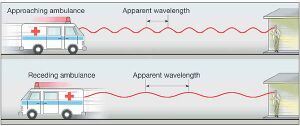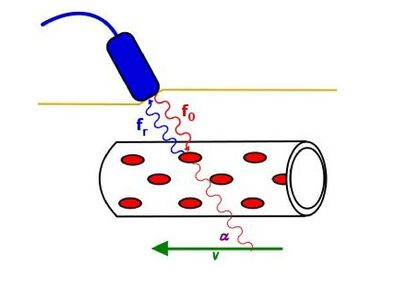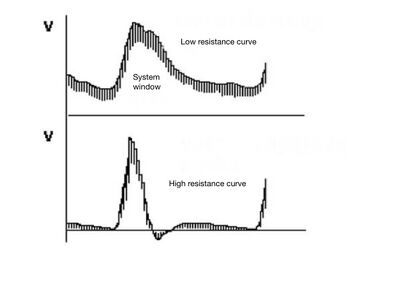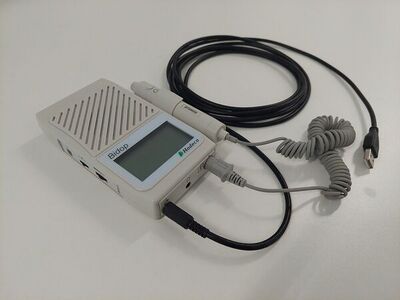Doppler sonography (2nd Faculty of Medicine, UK)
Job entry[edit | edit source]
- Measure blood flow in the radial artery using Doppler sonography.
Theoretical introduction[edit | edit source]
It is a modern, painless and now easily accessible examination method that uses two principles: ultrasound and the Doppler effect. The discoverer of the Doppler phenomenon was the Austrian physicist and mathematician, Professor Christian Doppler (1803-1853). It is used every day in the examination of the vessels of the neck, limbs, and organs (for example, examination of varicose veins, thrombosis, arterial blockages of the lower limbs and upper limbs, vessels in the head and brain), but also in obstetrics and neonatal medicine. Doctors consider Doppler sonography to be a great advance in the diagnosis of vascular diseases. However, there is still an open question of whether we can consider this method safe, especially when using ultrasound during pregnancy.
The advantage of this procedure is that the examination does not require irradiation of the patient with ionized or high-energy radiation. Other advantages are the cost of the examination, which is much lower than the cost of examinations using comparable imaging methods, as well as its wide use.
The disadvantage of the method is seen in the low permeability of areas with an interface that has different acoustic impedances (e.g. subcutaneous fat, gas in the intestine, or lung parenchyma).
Ultrasound is a type of mechanical wave with a frequency higher than 20 kHz, which is inaudible to the human ear. You can find more information about ultrasound here.
Doppler phenomenon[edit | edit source]
The Doppler effect is a phenomenon that consists in changing the frequency and wavelength of the received signal compared to the transmitted signal. Its reason is the non-zero mutual speed of the transmitter and receiver (observer). The Doppler phenomenon can be observed in practice when the pitch of the tones emitted by the siren on the roof of a passing vehicle changes. If the vehicle is approaching, we perceive a higher sound (shorter wavelength, higher frequency), if, on the other hand, it is moving away, we perceive a lower sound (longer wavelength, lower frequency). This phenomenon is used, for example, when measuring the speed of a car using radar. The Doppler effect affects both sound and electromagnetic waves, which is used especially in astronomy in the mutual movements of the Earth and space bodies. A shorter interval means a greater number of waves per second and therefore a higher frequency. In the case of light, this means that the spectrum of the receding star will be redshifted. By using the Doppler phenomenon, moving acoustic interfaces, for example, the movement of heart valves, can be well monitored.
In Doppler sonography, the Doppler phenomenon is used during the collision of an ultrasound wave with basic reflection structures in the flowing blood - erythrocytes , which function as point sources of wave dispersion and result in the formation of circular wavefronts, spreading in all directions. The energy of the ultrasound wave directed back to the wave source, which is lower than the energy of the transmitted ultrasound wave, is important for the generation of the Doppler signal. The difference between the transmitted frequency of the wave source and the received one is called the Doppler frequency shift ().
- the propagation speed of ultrasound in a given environment.
- Doppler angle (between the direction of the incident ultrasound beam and the direction of the flow).
- flow rate.
- transmitted frequency.
- received frequency.
- the vector component of the flow velocity parallel to the direction of propagation of the US.
The goal of Doppler methods is to measure the speed of moving structures. It is primarily a measurement of blood flow speed and, in combination with 2D imaging, a non-invasive measurement of blood flow.
- Continuous Doppler imaging - with this imaging, it is necessary to use a separate transmitter and receiver of ultrasound waves, suitably acoustically separated.
- Pulsed Doppler methods - are used in combination with echographic methods.
Doppler phenomenon in medicine[edit | edit source]
The basic reflective structures in flowing blood are erythrocytes. Due to the fact that their size is significantly smaller than the wavelength of the incident ultrasound waves, erythrocytes act more like point scattering sources that give rise to circular wavefronts propagating in all directions. These waves interfere with each other and their temporal and spatial summation occurs. The part of the energy of the ultrasound wave that is reflected back to the source is decisive for the generation of the Doppler signal. Amplitude of the reflected wave is proportional to the square of the total number of elementary reflectors (erythrocytes). The frequency of the reflected wave differs from the transmitted one due to the movement of the reflectors. If the blood flows towards the source of waves - to the ultrasound probe, then the frequency of the reflected waves is higher than the transmitted frequency, if the blood flows away from the source of waves, the frequency is lower.
The actual speed of blood flow depends on the Doppler frequency shift and Doppler angle (in the compressed direction of the Doppler beam and the direction of movement of the moving structure, e.g. blood flow). The angle of incidence of the Doppler signal relative to the direction of movement at the measurement point affects the shape of the spectral velocity curve. Underestimating the importance of the Doppler angle can lead to significant errors in velocity measurements, which are critical at angles greater than 60o.
Doppler sonography is used for other examinations, e.g.: to detect so-called silent bubbles,[1] which can be an accompanying sign of decompression sickness arising from bad procedures duringScuba diving.
Doppler systems[edit | edit source]
Doppler systems are currently designed as directional. For them, the flow speed towards the probe is referred to as forward, and away from the probe as reverse. Blood vessels and their branches offer a certain mechanical resistance to blood flow, which is analogous to the resistance offered by conductors to electric current. Peripheral vascular resistance is inversely proportional to the 4th power of the vessel radius. The geometry of the blood vessel determines not only the size of the peripheral resistance, but also affects the character of the flow during steady flow. If the velocity at the constriction exceeds a certain critical value, the laminar flow becomes turbulent–whirling. The velocity profile flattens at the point of turbulence, creating a large velocity gradient in the vicinity of the vessel wall. In a color image, the turbulent flow manifests itself as a mosaic of image structural units of different colors, indicating multidirectional flows. Unlike stationary flow, in which the fluid is always set in motion by the same force, blood flow in the vascular system has a pulsatile character. During systole the flow accelerates with maximum speed, during diastole it decelerates with minimum speed at the end of diastole. Continuous pulsatile flow is maintained by the elastic properties of the aorta and some other large vessels. These arteries represent a blood reservoir and thanks to the elasticity of their walls, during systole they temporarily transform part of the kinetic energy of the flowing blood into their elastic tension, and in diastole they return this energy to the flowing blood again. Another factor affecting the pulsatile nature of the blood flow and thus the Doppler spectrum is peripheral vascular resistance. Accordingly, we distinguish between low-resistance (arteries supplying the brain and parenchymal organs) and high-resistance (arteries supplying skeletal muscles) curves.
Usually we do not get the actual velocities, but only the components of the velocity in the direction towards or away from the probe. Therefore, if a probe measuring blood flow through a vessel is placed perpendicular to the vessel, it will measure zero velocity. The reflection occurs on the wall of the vessel and further, when passing through the blood (suspension of blood cells), a scattering phenomenon occurs, especially on the erythrocytes – the amount of waves that reaches back to the probe is small (the blood is almost anechoic), but it is enough to determine the frequency shift; from it the speed of the blood flow and the nature of the flow (laminar, turbulent) can be derived.
The spectral Doppler waveform enables semi-quantitative analysis of blood flow and assessment of hemodynamics . For a responsible assessment of hemodynamic changes, it is necessary to determine some parameters of the Doppler spectral curves. These include maximum systolic velocity S, minimum diastolic velocity D, S/D ratio (systolic/diastolic ratio), acceleration index AI (acceleration index), acceleration time AT (acceleration time), pulsatility index PI (pulsatility index) and resistance index RI(resistivity index, resistance index). These parameters have a great diagnostic value, provided that the measurement is sufficiently accurate. Correct setting of the so-called Doppler angle, i.e. the angle between the flow direction and the Doppler beam, is very important. The importance of these quantitative parameters will stand out when they are comprehensively evaluated, taking into account the anamnesis and the current clinical condition of the patient. However, the isolated use of just one parameter can lead to a diagnostic error. After marking the course of the speed curve, the device calculates the specified values automatically.
Definition of some parameters[edit | edit source]
Maximum systolic velocity – maximum velocity in systole. This speed usually corresponds to the early systolic peak (ESP - early systolic peak).
Minimum diastolic velocity (end-diastolic velocity) – flow velocity at the end of diastole.
Mean velocity , immediate or over a period of time. The determination of the instantaneous value is mostly based on the analysis of the Doppler spectrum – the velocities are weighted by the echo amplitudes, which are determined by the number of red blood cells participating in the echo generation. The average velocity per time period is then the average of the instantaneous velocities over a period of time, usually at least one cardiac cycle.
S/D ratio (systolic/diastolic ratio) – ratio of maximum systolic speed and end-diastolic flow velocities .
Resistance index (resistivity index, resistance index) – difference in maximum systolic speed and end-diastolic flow velocities , divided by the maximum systolic velocity . Increasing peripheral resistance leads to a decrease in diastolic velocity and the value of the resistance index increases. The resistance index can provide information on peripheral resistance even in parts of the investigated watershed that are not accessible to direct observation.
Pulsation index (pulsatility index), heart rate index – difference in maximum systolic speed and end-diastolic flow velocities , divided by the mean velocity (mean velocity, ); expresses the energy of pulsating blood. It has slightly different values for individual arteries and its diagnostic significance is not yet fully appreciated.
Heart rate (heart rate) is the number of heartbeats per time unit, most often per minute. , where is the length of the cardiac period.
In general, Doppler measurements can be performed in two modes.
Systems with an unmodulated carrier wave[edit | edit source]
Another name is continuous (continuous) Doppler imaging - (CW; continuous wave). They have a probe with two electroacoustic transducers, one of which functions permanently as a transmitter, the other as a receiver. The two converters tend to be inclined to each other at a very obtuse angle so that both beams, transmitted and received, overlap in the so-called sensitive area, which is relatively long (even several cm). The transmitter with one converter continuously generates an acoustic signal, so it cannot be switched to receiver mode. For blood flow velocities, the frequency shift is in the audible range, Doppler flowmeters are equipped with an acoustic output. Since flow signals coming from different depths are captured, it is not possible to distinguish flow velocities in individual vessels. The devices are simple and affordable, but the arrangement and location of the monitored vessels cannot be displayed,
Impulse modulated carrier wave systems[edit | edit source]
The abbreviation for these systems is PW, according to the English pulsed wave. The transmitting converter transmits in pulses. Systems with a modulated carrier wave are a combination of a pulsed ultrasound signal and the directional detection of its reflections from the flowing blood, which takes place in the section between the transmitted pulses. Unlike ultrasound imaging pulses, Doppler pulses have a slightly longer length and are transmitted with a higher repetition rate. The mode allows you to measure not only the change in frequency between the transmitted and received signal, but also the time it took for the reflected signal to return to the probe. The time delay between the sending of the pulse and the reception of its reflection determines the depth at which the flow velocity can be measured. This makes it possible to determine not only the speed of the flow, but also the depth at which the reflection occurred. The devices allow straight lines to display the direction of propagation of the ultrasound wave and to indicate the direction of blood flow; this leads to the automatic reading of the angle subtended by these lines. It is also possible to define the area in which the speed is measured - the so-called sampling volume. This makes it possible to monitor the speed distribution as well. The size of the sampling volume (gate) and its location in the vessel affects the result of the flow rate measurement. A narrow sampling volume, located in the center of the artery, measures the maximum velocity, a wide one, covering the entire diameter of the vessel, the average velocity. Doppler measurement in PW mode is possible on most commonly used devices, the result is displayed as a two-dimensional image of the measured velocities. The advantage of this method is the possibility of measuring velocity parameters at the chosen depth, without this measurement being negatively influenced by flows in other vessels lying between the probe and the sampling volume. in which the speed is measured - the so-called sampling volume. This makes it possible to monitor the speed distribution as well. The size of the sampling volume (gate) and its location in the vessel affects the result of the flow rate measurement. A narrow sampling volume, located in the center of the artery, measures the maximum velocity, a wide one, covering the entire diameter of the vessel, the average velocity. Doppler measurement in PW mode is possible on most commonly used devices, the result is displayed as a two-dimensional image of the measured velocities. The advantage of this method is the possibility of measuring velocity parameters at the chosen depth, without this measurement being negatively influenced by flows in other vessels lying between the probe and the sampling volume. in which the speed is measured - the so-called sampling volume. This makes it possible to monitor the speed distribution as well. The size of the sampling volume (gate) and its location in the vessel affects the result of the flow rate measurement. A narrow sampling volume, located in the center of the artery, measures the maximum velocity, a wide one, covering the entire diameter of the vessel, the average velocity. Doppler measurement in PW mode is possible on most commonly used devices, the result is displayed as a two-dimensional image of the measured velocities. The advantage of this method is the possibility of measuring velocity parameters at the chosen depth, without this measurement being negatively influenced by flows in other vessels lying between the probe and the sampling volume. A narrow sampling volume, located in the center of the artery, measures the maximum velocity, a wide one, covering the entire diameter of the vessel, the average velocity. Doppler measurement in PW mode is possible on most commonly used devices, the result is displayed as a two-dimensional image of the measured velocities. The advantage of this method is the possibility of measuring velocity parameters at the chosen depth, without this measurement being negatively influenced by flows in other vessels lying between the probe and the sampling volume. A narrow sampling volume, located in the center of the artery, measures the maximum velocity, a wide one, covering the entire diameter of the vessel, the average velocity. Doppler measurement in PW mode is possible on most commonly used devices, the result is displayed as a two-dimensional image of the measured velocities. The advantage of this method is the possibility of measuring velocity parameters at the chosen depth, without this measurement being negatively influenced by flows in other vessels lying between the probe and the sampling volume.
You can find more information about Doppler systems and the physical principle of Doppler sonography here.
Home preparation[edit | edit source]
Method[edit | edit source]
Equipment[edit | edit source]
- Doppler ultrasound measuring device Bidop Hadeco ES-100V3
- probe
- cable to probe
- gel for ultrasound examination
- PC program Smart-V-Link 4.1, Gimp 8.2 program
Workflow[edit | edit source]
Presentation on the instructions Doppler sonography, presentation instructions
During these practices, we work with a Bidop Hadeco (ES-100V3) portable Doppler ultrasound measuring device.
Discussion :
We will compare the lengths of the heart periods, if they are realistic and differ little from each other. (A large deviation probably indicates some error in entering the values.)
We will also assess other values and indices.
We compare the results of our detailed chart analysis with automatically calculated values and indices.
Conclusion :
We will consider whether the results correspond to normal values.
We will evaluate whether it is a low resistance curve or a high resistance curve.
We will return to the Title page and save the protocol again.
We will save the file with the protocol XXX_Dopplerovska_sonografie.ods on moodle after clicking on the item Doppler sonography (Submission of the protocol)
Parameters of the measured pulse wave:
- HR (Heart rate = pulse frequency)
- RI (Resistance index = resistance index)
- SD (Systolic / Diastolic ratio = ratio S / D)
- MEAN (Mean flow = mean velocity Vmean)
- PI (Pulsatility index = pulsation index)
Important notes on the experimental part[edit | edit source]
- Do not use the device on the chest, abdomen, head and neck.
- To prevent unwanted reflection of ultrasound waves, apply a 3 mm layer of gel to the point of contact of the probe with the examined body. As soon as the gel starts to dry, apply a new one. However, the gel must not cover too large an area, otherwise the probe will scan poorly.
- Use the probe to carefully and patiently search for a signal. It is a good idea to determine the place for the examination in advance, e.g. by palpation, as a place where you can feel the pulse with your fingers.
- After finding a suitable measurement point, do not move the probe (unlike classic sonography).
- In the program, individual buttons may unexpectedly stop working (they do not respond). Restarting the program can usually fix the problem.
Protocol[edit | edit source]
- To prepare the protocol, we will use the Doppler sonography protocol template from the Moodle server. Even before the start of the measurement, we can fill out the cover page of the protocol.
- We record the measured values directly in the tables during the examination.
- In the discussion, we can compare the values calculated by us with the values automatically calculated and theoretical assumptions with our measurement. Next, we will state a circumstance that has an influence on the result of the examination.
- In the conclusion, we will briefly state whether the result of our measurement corresponds to a normal finding and whether a low -resistance or a high- resistance curve was measured. We save the completed form and put it in the designated place.
Review questions[edit | edit source]
Attachments[edit | edit source]
Literature[edit | edit source]
- AMLER, Evžen, et al. Practical problems in biophysics I. 1st edition. Institute of Biophysics, 2nd Faculty of Law, UK, 2006.AMLER, Evžen, et al. Praktické úlohy z biofyziky I. 1. edition. Ústav biofyziky 2. LF UK, 2006.
- BARTUNEK, Filip. Doppler effect [online]. [feeling. 2015-11-19]. < http://www.fyzika007.cz/mechanicke-kmitani-a-vlneni/doppleruav-jev >.BARTŮNĚK, Filip. Dopplerův jev [online]. [cit. 2015-11-19]. <http://www.fyzika007.cz/mechanicke-kmitani-a-vlneni/doppleruav-jev>.
- NAVRÁTIL, Leoš and Jozef ROSINA, et al. Medical Biophysics. 1st edition. Prague: Grada, 2005. 524 pp. ISBN 80-247-1152-4 .NAVRÁTIL, Leoš – ROSINA, Jozef, et al. Medicínská biofyzika. 1. edition. Praha : Grada, 2005. 524 pp. ISBN 80-247-1152-4.
- FREEDOM, Emanuel, et al. An overview of high school physics. 4th edition. Prometheus, 2006. 532 pp. ISBN 978-80-7196-307-3 .SVOBODA, Emanuel, et al. Přehled středoškolské fyziky. 4. edition. Prometheus, 2006. 532 pp. ISBN 978-80-7196-307-3.
- HRAZDIRA, Ivo. Introduction to Ultrasound in Questions and Answers for Medical Students. 2008 36 s.
- BLOGG, Sl, GENNSER, M. et. al. Ultrasound detection of vascular decompression bubbles: the influence of new technology and considerations on bubble load. Diving Hyperb Med. 2014 Mar;44(1):35-44. PMID: 24687484
Related pages[edit | edit source]
- ↑ BLOGG, Sl, GENNSER, M. et. al. Ultrasound detection of vascular decompression bubbles: the influence of new technology and considerations on bubble load. Diving Hyperb Med. 2014 Mar;44(1):35-44. PMID: 24687484




















